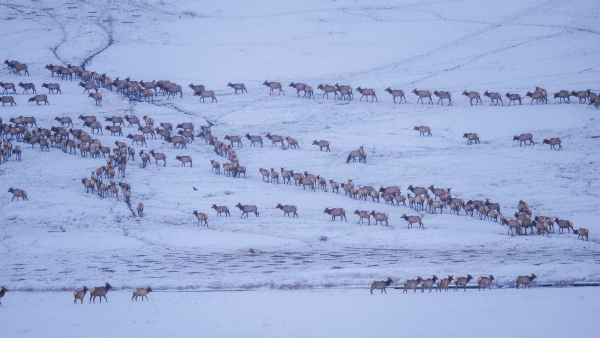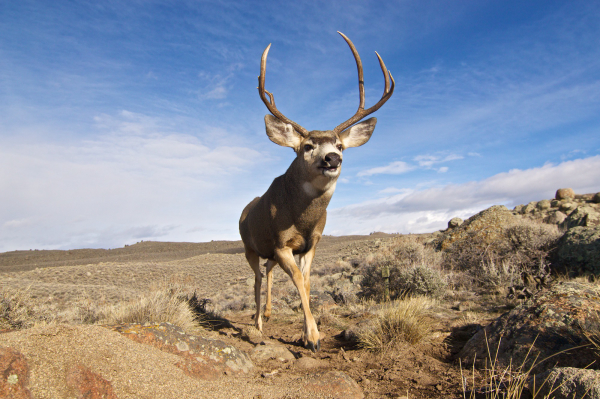States Focus on Big Game Migrations in the West
Ask many hunters across the country what their bucket list hunt is, and it would probably be a western big game hunt for elk, mule deer, or pronghorn. The vast landscapes these animals call home, with high-elevation forests and seemingly endless sagebrush sea, present the challenge and excitement for a dream hunt. These landscapes also define the lives of big game animals that must migrate across vast distances through the seasons to fulfill their habitat needs.

Hunters and westerners in general have long recognized that the deer they see in the sagebrush flats in mid-winter will be gone once spring unveils the newly sprouting forage in higher elevations. As the “green wave” moves up the hillside each spring, so too do the big game species as they follow the food that sustains them. They head to high elevations to fawn or calve, staying in the high country through the summer months before making the same trek back down. The advent of GPS wildlife collars has unveiled an even more detailed story about the life cycle of big game species, and the vulnerable habitats along their migration routes.
For decades, state fish and wildlife agencies have been at the forefront of managing big game populations, utilizing funds through the sale of hunting licenses as well as excise taxes paid by manufacturers of firearms, ammunition, and archery gear through the Pittman-Robertson Wildlife Restoration Fund. But the West is booming, and new housing construction, energy development, and increased traffic on roads coupled with wildland fires and the wide swing of drought to heavy snowpack, are all affecting big game populations.
Five years ago, the Department of the Interior’s Secretarial Order 3362 was signed to support state efforts to identify and improve big game migration corridors and seasonal ranges. According to the Department, direct funding to implement the Order over the last five years included $6.4 million for research and $2.5 million for mapping support to state fish and wildlife agencies. In addition, $20 million was directed toward habitat conservation and enhancement through a grant program coordinated by the National Fish and Wildlife Foundation. The new funding and focused attention have been invaluable to rapidly ramp up conservation efforts, however, states emphasize how important Pittman-Robertson funding has been to help them work with partners to implement big game habitat connectivity projects.
“Wildlife Restoration funds provide the foundation upon which state wildlife agencies support important priorities like identifying and conserving migration corridors and winter range,” said Jim Heffelfinger, wildlife science coordinator for the Arizona Game and Fish Department and chair of the Western Association of Fish and Wildlife Agencies’ Mule Deer Working Group. “The new funds through SO 3362 have been a shot in the arm, but traditional funding through license fees and excise taxes are critical to support personnel and leverage more dollars to implement this conservation on the ground.”
A key element of the enhanced efforts on big game migrations is utilizing GPS collar data to understand how deer, elk, and pronghorn utilize the landscape. The ability for new collars to send more data points allows scientists to use models to predict the high use areas—the maps make it easier to visualize where animals need help along their migration corridors or seasonal habitats. For instance, areas where corridors are extremely narrow due to topography or constrained by development, wildlife professionals may prioritize such areas for conservation easements; GPS data may also identify where animals “stop over” consistently along their migration routes, thus pinpointing places to restore habitats. The collar data reveal where roads create significant barriers to movement—data that informs transportation departments where a wildlife overpass or underpass could reduce wildlife-vehicle mortality.

While the new information allows states to work on a larger scale than they had previously, Pittman-Robertson funding is essential as a baseline. Don Whittaker, ungulate coordinator for the Oregon Department of Fish and Wildlife says that Oregon launched their Mule Deer Initiative in 2010. Over its first decade, $857,419 of Pittman-Robertson funding was directed to manage invasive plant species and remove junipers encroaching into sagebrush rangelands, as well as addressing barriers to movement including funnel fencing to support new wildlife crossing structures. This was matched through a variety of other sources for over $50 million in projects by 2019—the year after SO 3362 was signed. Whittaker says that in the next two-year funding cycle, the state plans to target $1.5 million for habitat projects in eastern Oregon.
“We have spent $2.5 million of primarily PR funds to radio collar nearly 2,000 mule deer with GPS collars since 2014. We have used this to identify herd ranges and migrations across their entire range in Oregon, this is instrumental in our efforts to manage the species and evaluate potential impacts of all the various proposals for development,” Whittaker says.

Jacob Gray with Idaho Department of Fish and Game says SO 3362 funding has been a boost for states but that their Wildlife Restoration Funds continue to be critically important because the program provides flexibility for implementing projects. Migrating wildlife do not worry about human boundaries between land management agencies or private landowners. To ensure big game species needs are met throughout their journey, agencies need to be able to implement projects where the animals go. Idaho has used Pittman-Robertson funds to work with private landowners interested in voluntary conversion of fences to wildlife friendly specifications to better accommodate wildlife movement through the seasons. Addressing cheatgrass infestations and improving habitat after rangeland fires are other priorities the state has undertaken, and they are able to do this work on federal, state, or private lands.
The winter of 2022-2023 is going down in record books for the heavy snow that has fallen in valley bottoms affecting big game winter range. Hard winters will continue, as will hot dry summers, wildfires, and development. Having more knowledge about the seasonal patterns of big game species will help wildlife managers to target conservation actions in the places where they are most needed to make the species more resilient to the harsh realities of life in the West. Using Pittman-Robertson Wildlife Restoration Funding, coupled with the increased attention through Secretarial Order 3362, state fish and wildlife agencies are making a difference for the big game species they manage. This is good news for the elk, mule deer, and pronghorn that benefit from habitat improvement efforts, as well as the hunters who dream of their bucket list western big game hunt.
– Jodi Stemler
In addition to being an award-winning outdoor writer and communicator, Jodi Stemler heads her own consulting firm specializing in conservation policy and communications projects. Her clients include the Boone and Crockett Club, the Mule Deer Foundation, the Wildlife Management Institute, the Theodore Roosevelt Conservation Partnership, Safari Club International, the Association of Fish and Wildlife Agencies, and many more.






